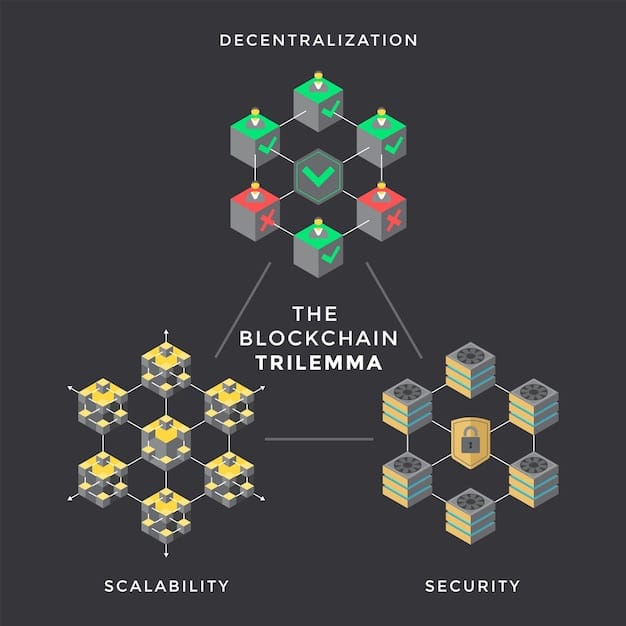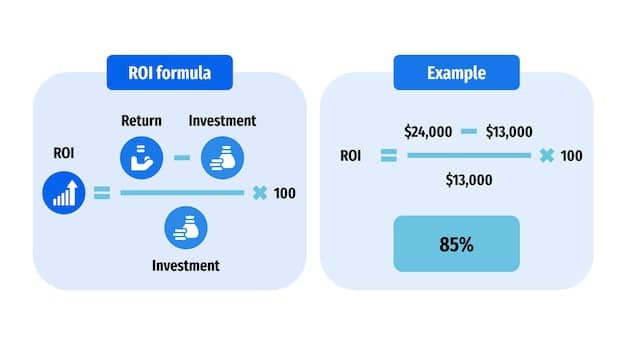Blockchain Scalability Solutions for US Businesses in 2025

Blockchain Scalability Solutions: A Comparison of Layer-2 Options for US Businesses in 2025 delves into how Layer-2 solutions address blockchain’s scalability issues, offering faster and cheaper transactions, crucial for US businesses aiming to leverage blockchain technology.
Blockchain technology holds immense potential for US businesses, but scalability remains a significant hurdle. The ability to process a high volume of transactions quickly and cost-effectively is crucial for widespread adoption. Blockchain Scalability Solutions: A Comparison of Layer-2 Options for US Businesses in 2025 is essential reading for those looking to navigate this complex landscape.
What are the most promising Layer-2 solutions available, and how do they compare in terms of performance, security, and cost-effectiveness? Let’s explore the options that could shape the future of blockchain adoption in the US.
Understanding Blockchain Scalability Challenges
Blockchain technology faces inherent scalability challenges. As the number of users and transactions increases, the network can become congested, leading to slower transaction times and higher fees. This is primarily due to the consensus mechanisms used by most blockchains, which require each transaction to be verified by multiple nodes.
For US businesses considering blockchain adoption, these scalability issues can be a major deterrent. High transaction costs and slow processing times can make blockchain impractical for many use cases.
The Blockchain Trilemma
The blockchain trilemma highlights the inherent tension between three desirable properties of a blockchain: security, scalability, and decentralization. Achieving all three simultaneously is a significant challenge.
- Security: The blockchain’s ability to resist attacks and ensure data integrity.
- Scalability: The network’s capacity to handle a high volume of transactions efficiently.
- Decentralization: The distribution of control across multiple nodes, reducing the risk of censorship and single points of failure.
Increasing one of these properties often comes at the expense of the others. For instance, increasing scalability might compromise security or decentralization. Layer-2 solutions aim to address this trilemma by offloading some of the transaction processing from the main blockchain.
In summary, blockchain’s scalability issues pose a real challenge for businesses in the US. Layer-2 solutions offer a potential pathway to overcoming these limitations and unlocking the full potential of blockchain technology for a wide range of applications.

Exploring Layer-2 Scaling Solutions
Layer-2 scaling solutions are protocols built on top of an existing blockchain (Layer-1) to improve transaction speed and reduce costs. These solutions handle transactions off-chain, only interacting with the main chain to settle the final state.
For US businesses, understanding the different types of Layer-2 solutions is crucial for choosing the right approach for their specific needs. These solutions offer a promising path towards achieving the scalability required for real-world blockchain applications.
State Channels
State channels enable participants to conduct multiple transactions off-chain while only submitting two transactions to the main chain: one to open the channel and one to close it. This significantly reduces the load on the main blockchain.
- Lightning Network (Bitcoin): A popular state channel implementation for Bitcoin, enabling instant and low-cost Bitcoin transactions.
- Raiden Network (Ethereum): An Ethereum-based state channel network designed for fast and scalable ERC-20 token transfers.
State channels are well-suited for applications where frequent and repeated interactions occur between a fixed set of participants. However, they require participants to lock up funds in the channel, which can limit their flexibility.
Sidechains
Sidechains are independent blockchains that run parallel to the main chain. They have their own consensus mechanisms and block validation rules, allowing them to handle a higher volume of transactions.
- Polygon (Matic): A popular sidechain for Ethereum, providing a scalable and low-cost environment for deploying and using decentralized applications.
- Liquid Network (Bitcoin): A sidechain for Bitcoin designed for fast and confidential Bitcoin transactions between exchanges and traders.
Sidechains offer greater scalability than state channels but introduce a higher level of trust, as they rely on their own consensus mechanisms. They are well-suited for applications that require high throughput and customizability.
In conclusion, Layer-2 solutions like state channels and sidechains are essential for addressing blockchain scalability challenges. Each approach has its own strengths and weaknesses, making it important for US businesses to carefully evaluate their options.
A Detailed Comparison of Layer-2 Options for US Businesses in 2025
The choice of Layer-2 solution depends on various factors, including the specific use case, the desired level of security, and the cost-effectiveness. For US businesses looking to implement blockchain technology in 2025, a thorough comparison of the available options is vital.
Let’s delve into a more detailed comparison of some of the leading Layer-2 solutions, focusing on their key characteristics and suitability for different business applications. This Blockchain Scalability Solutions: A Comparison of Layer-2 Options for US Businesses in 2025 will provide valuable insights.
Throughput and Transaction Costs
Throughput refers to the number of transactions that a Layer-2 solution can process per second (TPS), while transaction costs reflect the fees associated with each transaction. These are critical metrics for evaluating the performance of a Layer-2 solution.
For US businesses, high throughput and low transaction costs are essential for supporting a large volume of transactions and making blockchain applications economically viable.
Security Considerations
Security is another crucial factor to consider when evaluating Layer-2 solutions. Different solutions employ different security mechanisms, and some may be more vulnerable to attacks than others.
- State Channels: Generally considered very secure, as transactions are ultimately settled on the main chain.
- Sidechains: Security depends on the consensus mechanism of the sidechain itself, which may be less robust than the main chain.
US businesses should carefully assess the security risks associated with each Layer-2 solution and choose one that provides an acceptable level of protection for their assets and data.
Ease of Integration
The ease of integration with existing systems is another important consideration for US businesses. Some Layer-2 solutions may require significant development effort to integrate with existing applications and infrastructure.
Choosing a Layer-2 solution that offers a user-friendly API, comprehensive documentation, and readily available development tools can significantly reduce the cost and complexity of integration.
In summary, US businesses need to carefully evaluate the throughput, transaction costs, security, and ease of integration of different Layer-2 solutions to determine the best fit for their specific needs and requirements. This comprehensive approach is a critical part of effectively implementing Blockchain Scalability Solutions: A Comparison of Layer-2 Options for US Businesses in 2025.

Assessing the Maturity and Adoption of Different Solutions
The maturity and adoption of a Layer-2 solution can significantly impact its long-term viability and support. US businesses should consider the track record, ecosystem, and developer community of each solution before making a decision.
A more mature and widely adopted solution is likely to have a larger developer community, more readily available resources, and a lower risk of being abandoned in the future.
Community Support and Development Activity
The size and activity of the developer community surrounding a Layer-2 solution are important indicators of its long-term prospects. A vibrant community contributes to the ongoing development, maintenance, and improvement of the solution.
- Look for solutions with active forums, comprehensive documentation, and readily available support channels.
- Consider the number of developers contributing to the project on platforms like GitHub.
US businesses should prioritize solutions with strong community support to ensure access to ongoing updates, bug fixes, and new features.
Real-World Use Cases
Examining real-world use cases can provide valuable insights into the practicality and effectiveness of a Layer-2 solution. Look for examples of businesses that are successfully using the solution to address their scalability challenges.
Consider the specific industry, application, and scale of these use cases to determine if the solution is well-suited for your own needs. Evaluating practical applications of Blockchain Scalability Solutions: A Comparison of Layer-2 Options for US Businesses in 2025 is crucial.
In conclusion, US businesses should carefully assess the maturity and adoption of different Layer-2 solutions, considering factors such as community support, development activity, and real-world use cases. This evaluation will help them choose a solution that is likely to be sustainable and well-supported in the long term.
Future Trends in Blockchain Scaling
The landscape of blockchain scaling is constantly evolving, with new solutions and technologies emerging regularly. US businesses need to stay informed about these trends to make informed decisions about their blockchain strategy.
As blockchain technology matures, we can expect to see further advancements in Layer-2 solutions, as well as the emergence of new scaling paradigms. These innovations will play a critical role in enabling the widespread adoption of blockchain technology.
The Rise of Zero-Knowledge Proofs (ZK-Rollups)
ZK-Rollups are a promising Layer-2 scaling solution that uses zero-knowledge proofs to bundle multiple transactions into a single proof, which is then verified on the main chain. This significantly reduces the transaction costs and improves scalability.
ZK-Rollups are gaining traction as a highly secure and efficient scaling solution, particularly for applications that require privacy and confidentiality.
Cross-Chain Interoperability
Cross-chain interoperability refers to the ability of different blockchains to communicate and interact with each other. This is becoming increasingly important as the blockchain ecosystem becomes more fragmented.
Solutions that enable seamless cross-chain communication can unlock new possibilities for interconnected applications and services, further enhancing the scalability and utility of blockchain technology. Considering these future trends is vital when thinking about Blockchain Scalability Solutions: A Comparison of Layer-2 Options for US Businesses in 2025.
In summary, the future of blockchain scaling is likely to be driven by advancements in ZK-Rollups, cross-chain interoperability, and other innovative technologies. US businesses should stay informed about these trends and explore how they can leverage them to improve the scalability and efficiency of their blockchain applications.
| Key Aspect | Brief Description |
|---|---|
| ⚡️ Throughput | Transactions per second (TPS) vary by Layer-2 solution. |
| 🛡️ Security | Security levels depend on the specific Layer-2 mechanism used. |
| 🛠️ Integration | Ease of integration varies; some solutions offer user-friendly APIs. |
| 🚀 Adoption | Adoption rates differ; maturity influences long-term support. |
Frequently Asked Questions
Layer-2 solutions enhance throughput, reduce transaction costs, and improve overall efficiency by processing transactions off-chain. For US businesses, this means faster and more affordable blockchain applications.
State channels enable participants to conduct multiple transactions off-chain, only submitting two transactions to the main chain. This reduces congestion and transaction fees on the main blockchain.
Popular options include Polygon, which provides a scalable environment for Ethereum-based applications, and the Lightning Network, designed for fast and low-cost Bitcoin transactions. These are key Blockchain Scalability Solutions: A Comparison of Layer-2 Options for US Businesses in 2025.
The security of Layer-2 solutions varies. State channels are generally considered very secure, while the security of sidechains depends on their own consensus mechanisms. Always carefully assess security.
Consider factors such as the specific use case, desired level of security, cost-effectiveness, and ease of integration. A thorough evaluation is essential for making an informed decision about Blockchain Scalability Solutions: A Comparison of Layer-2 Options for US Businesses in 2025.
Conclusion
In conclusion, Blockchain Scalability Solutions: A Comparison of Layer-2 Options for US Businesses in 2025 is crucial for unlocking the full potential of blockchain technology. By understanding the various Layer-2 solutions available, US businesses can make informed decisions and pave the way for efficient, secure, and scalable blockchain applications.
The future of blockchain adoption hinges on addressing scalability challenges effectively, and Layer-2 solutions offer a promising path forward, enabling businesses to leverage the benefits of distributed ledger technology without being constrained by performance limitations.





